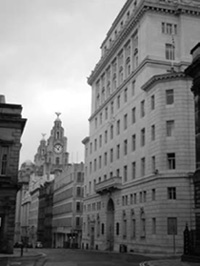
Coming as I do from Southampton, I have long regarded Liverpool as everything my hometown could have been but wasn’t. The port that succeeded it in the 1910s was never interested in emulating its architectural grandeur, and some seem to find this a good thing—both those who fear a Solent City, and the occasional Liverpudlian sentimentalist. In 1984 Beryl Bainbridge wrote an English Journey in tribute to Priestley, and she too started in Southampton. Although she seemed to have spent all of five minutes in the city—at least, unlike in her account of Milton Keynes, she managed to get out of her car—she was pleased to find that the port that had ‘done in’ Liverpool was not, unlike her hometown, somewhere big, dark and grandiose, but a mere ‘holiday village’, jolly and quaint, and good for yachting. Maybe all of Britain could be one big holiday village. Maybe, as Prince Charles once advocated, Toxteth could turn ‘back into countryside’, as has parts of Detroit.66 Hell, let’s just dissolve the cities altogether, destroy the tower blocks and write off the last 150 years as a mistake.
The great thing about Liverpool is that it, at first sight, has no truck with this whatsoever. It is not a village. It’s a dramatic, great city, and at its centre is the most wholly and thrillingly urban environment in England outside of London. Cliché it may be, but with Liverpool comparisons are never really to Manchester, Leeds, Bristol, let alone Southampton, but to Berlin, Hamburg, New York. Walking round the commercial centre built up around the Pier Head, there is alternately a crucible of modern architecture, in the form of the steampunk iron and glass experiments of Peter Ellis’s 1864 Oriel Chambers or the mutilated 1906 Cotton Exchange; the stripped, classical, steel-framed interwar towers of C. H. Reilly’s Liverpool school; bizarre eruptions of sixties modernism, like Bradshaw Rose and Harker’s former HSBC Building, a Czech Cubist experiment in black glass; a telecommunications tower of the sort a Canadian or German city would find entirely normal but the English faintly hubristic; and at the head itself, W. A. Thomas’s Tower and Liver Buildings, the latter the only English work of the twentieth century to have influenced skyscraper design elsewhere, rather than vice versa. The architectural richness here is so overwhelming you feel almost spoiled by it. Further up, the Georgian terraces and the brilliantly ludicrous competing cathedrals offer views of an astonishing skyline, easily the finest in Britain. It’s not enough. The problem is amply demonstrated by the fact that this magnificent metropolis was supplanted so quickly and easily by Southampton. Liverpool’s recent history is a massive demonstration of the unnerving fact that many don’t seem to want cities, even one as good as this. The reasons for this are not wholly aesthetic.

A view down to the Pier Head
Liverpool has experienced a resurgence, not necessarily in economic terms—it is still the poorest city in Britain—but in terms of national prominence. Its year as European Capital of Culture in 2008, which left a legacy of Superlambananas and unfinished museums, acquired a certain art-house grandeur through Terence Davies’s vainglorious Of Time and the City, a sometimes witty but mostly thumpingly banal city portrait, all tourist-board shots of the Pier Head’s ‘Three Graces’ and booming renditions of startlingly obvious poetry half-remembered from school (‘Ozymandias’, ‘Into My Heart an Air That Kills’—you half expect him to intone ‘To be or not to be: that is the question’). As Sukhdev Sandhu was almost alone in pointing out, Davies’s film said nothing about time other than ‘it passes’ and nothing about the city other than ‘it ain’t what it used to be’, but with undeniable visual assurance it fixed in celluloid an accepted narrative: the city was betrayed, and betrayed by the planners. So the postwar towers rising from the slums, or from the picturesque ruins left by the Luftwaffe—‘we were promised paradise,’ he wonderfully intones, ‘but municipal architecture, combined with the English talent for the dismal, made for something far from Elysian’—is mixed in with footage of far more interesting 1930s schemes, when Liverpool’s municipal architect Lancelot Keay was considered one of the best designers and planners in the country. What the film doesn’t feature is the fact that these schemes nearly all went down in their turn, at the hands of the last great municipal socialist experiment in Britain.
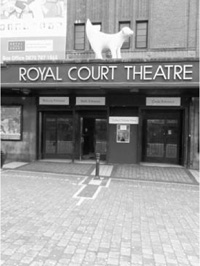
Superlambanana
Most recent accounts of Liverpool will mention Militant, along with the Toxteth riots, as an example of the ‘basket case’ the city had become by the 1980s. For much of that decade, until the ‘Liverpool 47’ were forcibly removed from office in 1987, the Labour council was essentially controlled by Militant, a Trotskyist organization operating semi-clandestinely within the Party, which after mass expulsions now enjoys occasional moderate electoral success in Preston or Coventry as the Socialist Party. The council’s heads, Derek Hatton and Tony Mulhearn, seemed to represent the two stereotypes of both Liverpool and Marxist politics: one a dodgy geezer, whose fame has endured since; the other a quiet, academic figure, still politically active but lacking his former comrade’s business ventures and talk radio shows. Regardless, ever since Neil Kinnock ill-advisedly decided that attacking his own party was the best way to win an election, Liverpool City Council has stood in for failure and chaos, the final death of the long-standing Labour tradition of reforms through local government, at the hands of those who had always claimed reform was impossible anyway. Oddly enough, however, Militant’s municipal legacy is very unlike that of its reformist forbears. No Karl-Marx-Hof, no Park Hill or even Byker was left by them, although they built thousands of housing units. The diametric opposite of former Trotskyist T. Dan Smith’s dirigiste ‘Brasilia of the North’, in architectural terms Militant’s policy was perhaps the widest-scale attempt to give people what most (if not all) always said they wanted—a house and garden, close to their place of work.
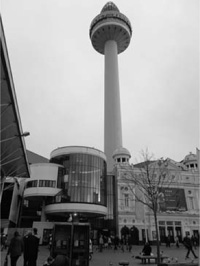
Liverpool Futurism—the Playhouse and the TV Tower
Frankly, the effect is bizarre, warping a metropolis into Beryl Bainbridge’s ‘holiday village’. It’s as if the city were straining all sinews to actually become as boring as Southampton. Accounts from the sixties, like that of Ian Nairn, argue that postwar architecture in the city was far less interesting than that of, say, Sheffield, and Davies’s footage of some humdrum system-built blocks generally supports this. However, the case is quite different with the 1930s ‘tenements’, which feature just as heavily in Of Time and the City as emblems of far from Elysian municipal architecture. These brick blocks of flats, taking after the more unambiguously municipal socialist precedents of the cities with which Liverpool is rightly compared—Hamburg, Vienna, Berlin, Rotterdam—were designed as an attempt, conscious or otherwise, to make a city in which giant office blocks and cathedrals dissolved into back-to-backs and two-up-two-downs into something more coherent and genuinely metropolitan, giving the working-class areas of the city the kind of dramatic urban grain that the commercial centre took for granted. These too were demolished, first by Militant and then by the various more politically conformist regimes that followed it. One tenement complex in Old Swan went down as late as 2001, to be replaced by a Tesco. By way of comparison, in Glasgow it had been commonsensical for years that tenements were as decent a form of housing as any other, with ‘tenement rehabilitation’ well into its third decade. So an experiment in convincing the English to live in low-rise apartment blocks, in making an English city as honest about its urbanity as a Scottish or European one, became another smugly accepted failure.
The reasons for this, however, are easily understandable. Liverpool is the only British city to have really experienced the kind of drastic population drop considered normal in postwar American cities, declining by around half between the 1940s and 1990s, from around 850,000 people to something around 400,000. So what possible need could there be for apartment blocks? If there was enough space and few enough people, why shouldn’t every council tenant have their own house and garden? The only counter-argument is aesthetic, due to the incontrovertible fact that as a result of this policy, whole swathes of inner-city Liverpool look utterly ridiculous. One moment you’re in Berlin, the next in Basingstoke. Walking along Park Road in Dingle, you can see how Militant took up the theories of ‘defensible space’ and Alice Coleman’s walkway turd-counting, so that the semis are not for the most part arranged in terraces, but in closes and cul-de-sacs, with brick walls screening them from the street and all its unpredictability. In his spirited self-defence Liverpool—A City That Dared to Fight, Tony Mulhearn even quotes Coleman’s approval of his housing policy, not pausing to wonder why an architectural adviser to Margaret Thatcher might be praising low-density housing in inner cities.
It’s horribly sad. They’re not bad houses, in their drab way, and residents have often dressed the exteriors up in a manner which would be difficult in the tenements and towers. They cost much less in upkeep than a block of flats, so nobody has to reckon with piss-stained or broken lifts. They cater for the very people—working-class families—who have been designed out of Manchester or Leeds. They have the virtue of being in the centre of a city, rather than in the suburbs from whence they borrow their forms; but they just look so utterly wrong. It’s not dignified for the city centre to mimic the ‘burbs. It leads to depressing juxtapositions—as at the point where the grand sweep of the major surviving thirties tenement block, St Andrew’s Gardens (now gated student flats) meets a piddling close of nineties semis, with the Metropolitan Cathedral of Christ the King in the background. The scale is preposterous, with the houses seeming to desperately want to be somewhere less dramatic, a murmur of discontent with the idea of getting above your station. It’s not for the likes of us. Walk from Dingle to the centre and wasteland punctuates the cul-de-sacs, revealing the sudden howl of Giles Gilbert Scott’s other Cathedral, beamed in from another planet, until you get to a set of bungalows. Bungalows, for God’s sake, you think, as it all becomes a tragicomedy. Why didn’t London hit on the idea of building bungalows in Whitechapel? One of the bungalows has ‘GRASS’ spray-painted onto it. Then you see a black car park, a ‘GROSVENOR’ sign, and you’ve entered one of Militant’s more unexpected legacies in the city.
St Andrew’s Gardens, designed by John Hughes under Lancelot Keay
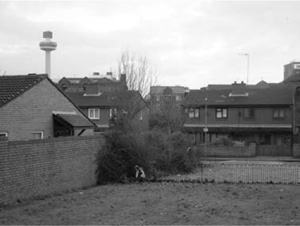
Militant semis
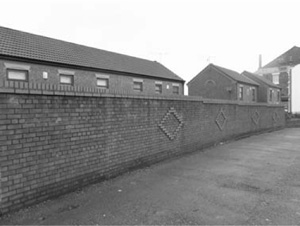
Park Road, Dingle
Semis, Metropolitan Cathedral
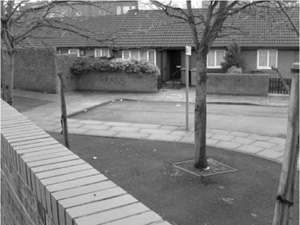
Militant bungalows, next to Liverpool One
After defeat in the battle over ‘rate-capping’ with Thatcher’s government (put simply, her successful attempt to curb the city’s abundant spending on housing and social facilities), Liverpool City Council sold off a swathe of publicly owned land in the centre, around Paradise Street. This in turn was bought up by a developer, who sat on it for years before being bought out by the Duke of Westminster’s property company, the aforementioned Grosvenor. The result has been alternately lauded or reviled depending on whether you’re reading a newspaper or an architecture magazine. It was criticized before it had even been completed by Paul Kingsnorth in the Guardian, for creating a ‘mall without walls’, a privatized city-district where public rights of way were irrelevant, an enclave shutting itself off and boasting its own private security force and a policy of keeping undesirables off its streets. Anna Minton features it in her brilliant indictment of Blairite urban policy Ground Control as a prime example of the creeping securitization and privatization of the British city, motivated by fear and greed. I don’t intend to disagree with either of these accounts when I say that my feeling upon entering Liverpool One was not horror at entering a new dystopia, but a sense of relief after so much visual impoverishment along Park Road—some architecture, finally, aside from the distant silhouettes of the cathedrals and the Liver Building. Some planning, some urban coherence, some sense that I was somewhere special rather than somewhere trying desperately not to be special.
Before I went to Liverpool One I spoke to an architect at BDP, the firm that master-planned the scheme and hired a diverse group of architects to design the individual buildings. He recommended a route where I would not be able to see the join between the old city and the new roofless shopping complex in its midst, in response to my Minton-influenced arguments about its exclusive demarcation between itself and the surrounding area. That might be the case at one exit, but at all others the screens, signs and fittings immediately announce a rupture. But then why should it try to blend in? The maniacal megalopolis of the Pier Head owed very little to the Georgiana of Hope Street. More contentiously, he dismissed worries about the privatization of public space by pointing out that a local council would be unwilling or unable to look after such a development, claiming that regeneration schemes elsewhere—like BDP’s own Ropewalks—had fallen into dilapidation because of municipal indifference (it merely looked as though it had been lived in a bit when I visited). He included most developers in this too, claiming that a shopping-mall developer like Hammerson would be far less inclined to treat this area in the way Grosvenor have done—as if money is no object, which in the case of the Duke of Westminster it is not, so finishes on the buildings are of a far higher standard than almost anything else built over the last decade. Feudalism, it seems, is able to achieve results where neoliberalism or municipal socialism have failed.
The private city-district
BDP were also the designers of WestQuay, and Liverpool One marks one of the many ways that the Mersey port has taken revenge on its southern rival. Architecturally, there’s no doubt that Liverpool One is good, especially compared with the appalling WestQuay, and some of the attacks on it seem misplaced. Dutch architect and critic Hans van der Heijden of BIQ Architecten designed new buildings for Bluecoat Chambers in a red-brick vernacular attempt to create serious architecture in the midst of Liverpool One’s commercial frivolity. Not only is this a misreading of the far from traditionalist architecture of central Liverpool; BIQ’s structures actually slot rather well into the panoply of registers and references, and at first I don’t realize that they’re from a different project. The buildings on the ground are mostly excellent—FAT’s sweet-shop kiosks are as garishly playful as one would expect, Dixon Jones’s arcades as chic and sober. Even those by often mediocre practices are fine. CZWG’s ‘Bling Building’ is as embarrassing and enjoyable as old men talking about ‘bling’ tend to be, but more surprising is Glenn Howells’ row of shops culminating in a tower, its golden frame the most striking element in the whole scheme—until, that is, you start to traverse the walkways and escalators that lead up to BDP and Allies & Morrison’s South John Street. Suddenly, all the walkways that we were told led to crime and desolation are in place, swooping across each other, a Piranesian spectacle in pink and green. The stairs from here lead to a raised park, concluding what is one of the very few actually pleasurable walking experiences created by the Urban Renaissance, a school of thought that otherwise remains boringly earthbound. There is more than a ghost of Park Hill or Thamesmead here (the BDP architect I spoke to talks of his admiration for the Smithsons), and it finally injects a bit of excitement into the prosaic act of getting from A to B, a form of planning based on movement through spaces, for once, rather than sitting wanly sipping a coffee. At this point I’m suddenly disarmed. I had expected to hate this place, to see it as the culmination of the idiocies of Blairite urbanism, but in fact, it’s almost everything I like about architecture, albeit in heavy disguise.
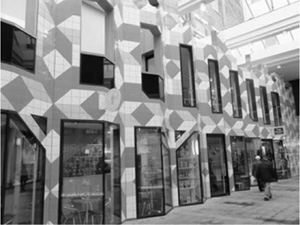
FAT’s Liverpool One Pavilion
After the triumph of the walkways and Chavasse Park, the reality of the place begins to sink in, and I notice that some of Liverpool One’s architecture is actually quite poor—Aedas’s dull Hilton Hotel, Cesar Pelli’s silly, strained One Park West tower. I realize that I have absolutely no desire to buy anything, which means that the place is a functional failure at least in my case. To see architecture as good as at least half of Liverpool One is housing Waterstone’s and Tie Rack creates a definite bathos. And to praise the buildings and the plan does not automatically mean that the claim by the Stirling Prize judges, that Liverpool One ‘single-handedly reversed the city’s fortunes’, stops being insulting nonsense. This is still unashamedly designed for consumers from Cheshire rather than Bootle (hence the many car parks), and it’s still a CCTV-ridden enclave where civic virtues are secondary to the imperative to spend spend spend. Yet the unexpected brilliance of Liverpool One is perhaps appropriate. Every society erects its finest buildings for what it considers to be the most important function, whether it be the glorification of a deity, of capital, or of council housing. Liverpool One is our finest monument to shopping, to the dazed purchase of Chinese-made consumer goods and the precarious just-in-time production behind them. Its buildings are display fronts, with little underneath—FAT even draws attention to this, with its Liquorice Allsorts wall giving way to a void and an escape staircase. I would love something with this much care and attention to be devoted to a function of some genuine worth, but this at least has the virtue of macropolitical neatness.
Glenn Howells’ tower, Liverpool One
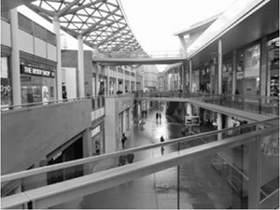
Liverpool One walkways
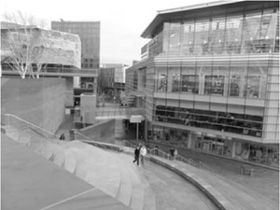
Liverpool One from Chavasse Park
To see how little other functions are valued, walk to the other side of the Pier Head, where culture and accommodation are encompassed by some extremely shoddy and banal buildings, and walk from there to the remnants of the docks. First the Pier Head itself, where three very different buildings have been fixed forever as the ‘Three Graces’ and two new buildings which sum up the problem of British architecture with depressing acuity now share the riverfront with them. One is the Museum of Liverpool, unfinished but nearly complete at the time of writing. Designed by Scandinavian architects 3XN (subsequently sacked, so their design is now somewhat bastardized), it stands as the current mutation of the north European urbanism of which Liverpool was the finest, and arguably only, English example. However, because Liverpool’s architecture has not itself kept pace with developments in its fellow northern ports, it is treated as an alien intrusion onto an ensemble fixed in time. But the worry about the appropriateness or otherwise of this building, an immaculately stone-clad, snaking structure standing aside at a respectful distance from the Graces, is perhaps less offensive than the first positive reaction to its presence. That is, the new Pier Head Terminal, by prolific hacks Hamiltons, which is quite precisely a bonsai version of the Museum, only tricked out in a much cheaper stone with additional jagged sub-expressionist windows cut into it, housing a Beatles Museum and a new Terminal, providing an introduction to a city which wants to be a passenger port once again. It stands in front of the Liver Building taking the piss, and was the justified winner of the 2009 Carbuncle Cup, the award for worst building of the year given out by Building Design. In its pathetic, Lidl version of the New Thing, it is a new gateway to a servile, provincial nation, unable to produce anything of worth but only cheap imitations of other, less hidebound peoples’ ideas.
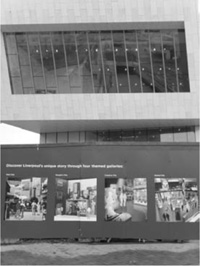
The Museum of Liverpool, under construction
Hamiltons’ Pier Head Terminal
Further on from here are a cluster of towers, almost all far duller than what would be built in Manchester or Glasgow (as in Liverpool, nobody is looking), by Ian Simpson, Aedas and AHMM. Of the latter’s two skyscrapers, one has a certain kitschy, sci-fi joie de vivre, the other is a banal barcode façade. As a cluster, distance flatters it, but up close this is inept urbanism, randomly scattered towers with wasteland and howling main roads in between. That is, until you get to the start of the docks, the kind of port where you can enjoy walking, the opposite of Southampton’s vast screened-off container reservation. It was certainly once intended to be seen. The Dock Road runs along the former path of the Liverpool Overhead Railway, an elevated line built in the 1890s, directly equivalent to New York’s ‘High Line’, which was regularly advertised as a tourist attraction, to give a panoramic view of Liverpool Shipping. It was demolished in the 1950s because neither government nor business was interested in funding its refurbishment, one of the earliest of many snubs to Liverpool’s aspirations to metropolitanism. That said, the impression that this dock wall was ever permeable by members of the public is anachronistic, and what you can look at here is not a working, living dock—it’s a ruin. There are miles of dereliction before you reach the entity which still functions and trades (lucratively enough) as the Port of Liverpool. In the mid nineties, this was the site of one of the last major industrial disputes in Britain, the Liverpool Dock Strike, one of those evanescent moments where a strike stopped being just about Pay And Conditions, but became about abstractions—casualization, de-industrialization, a declaration of solidarity. It disappeared from prominence as quickly as it arose, but Liverpool has a long memory.
It’s walled, the derelict dock, but the walls themselves are architecturally detailed, while the gates and the walkable road that runs along them provide constant sights, snatches and views into a seafaring architecture, which even in its most prosaic moments has a romance to it, a feeling of potential escape, the sense that you could just get on a boat from here and get out of Britain—a feeling I have never had in Southampton. The reason is that you no longer feel like you’re in Britain here, but rather an international zone, a space where transit is romantic rather than a matter of mere distribution. Along the dock wall you can see a litany of industrial curios with a similar strange power and ruthless ambition to the century-old office blocks in the centre: a cyclopean ventilation shaft like one of Antonio Sant’ Elia’s futurist power stations, the enormous arch of the Tate & Lyle Grain Silo a rare reminder of the dubious money and Caribbean labour behind the Tate Gallery a mile upriver. Interrupting it all—blocking the road, in fact—is the Stanley Dock, the place where this journey ends.
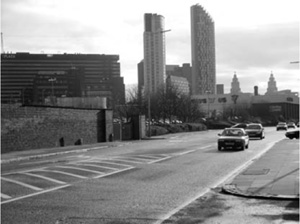
The new Liverpool skyline
AHMM’s Unity Tower
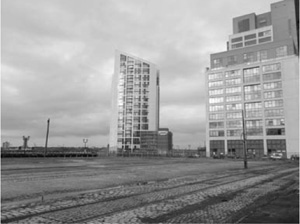
The voids of regeneration

The Wasteland on the other side of the wall
It’s blisteringly, skin-scrapingly cold, in the dead centre of the longest, bleakest winter for decades, a winter which has passed without the expected discontent. Vague, confused anger and despair is the prevalent mood instead, here in Liverpool as much as everywhere else. Fluttering in the wind is some torn police tape, and the mechanical bridge over the dock is blocked by several caravans, with a pink wheelie bin and a pink child’s tricycle in front of them. Adjacent to this mobile architecture is the rotting black and red masonry of the 1901 Stanley Dock Tobacco Warehouse, reputedly the largest brick building in the world. Just a few yards north of the Warehouse, along a canal, is the Eldonian Village, a housing co-operative built in the politicized mid eighties. Its residents had input into the design, which is, a couple of thoughtful details aside, indistinguishable from any area of outer suburban housing anywhere in the country—it feels like a piece of Berkshire in Manhattan.
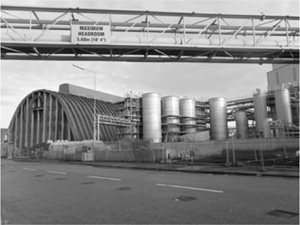
The other Tate
Caravans at Stanley Dock
Together, the Dock, the Caravans and the Village provide three possible ways out of the Blairite city. At Eldonian Village, still a housing co-op today, there’s a scheme which involves all the democratic control and popular politics that are completely absent from today’s urban planning, housing the people who are now expelled by hook or by crook from the city centres. It also entails the rejection of urban architecture entirely, in favour of reduced versions of the houses of the nineteenth century, arranged in cul-de-sacs; giving people what they say they want, and in so doing abandoning the idea that the design of British cities can be anything other than provincial and backward-looking—something especially sad in a city which once spectacularly proved otherwise. At Stanley Dock, there is the monumentalism of industry, gigantic creations of production and distribution, the forbears of the giant distribution sheds of our times, only put at the centre of a culture rather than hidden away somewhere off the motorway. And then there are the caravans, homes on which you’ll never have to pay a mortgage, a totally modern architecture that is no longer even tied to a fixed site. An old idea of urbanism is utterly ruined, here at Stanley Dock, and you can smell its decomposition. Yet it feels so much less ruinous than the desolate city of property and tourism just a couple of miles away.